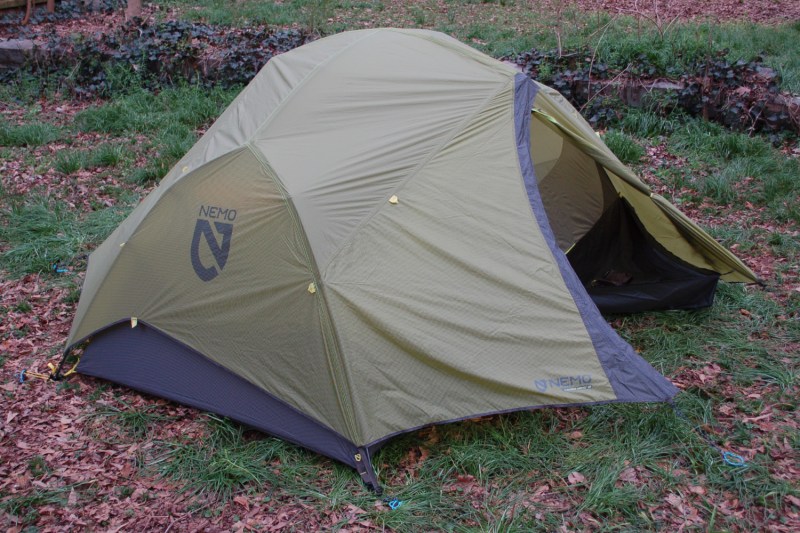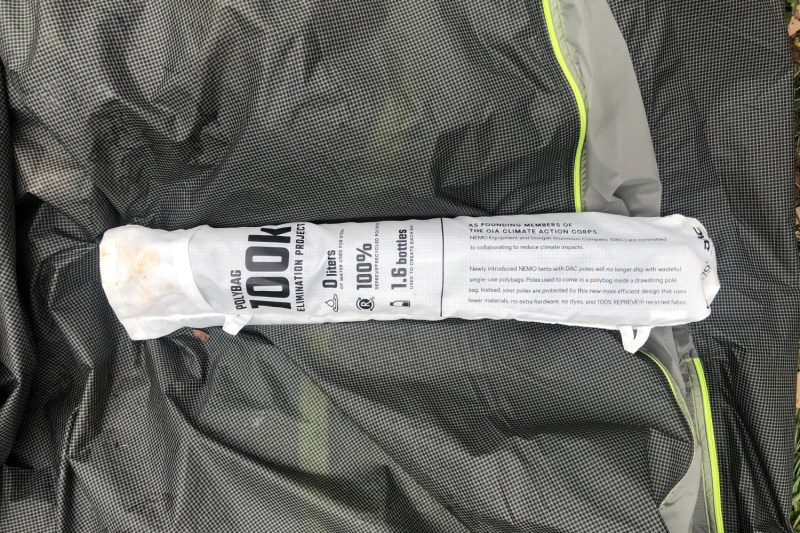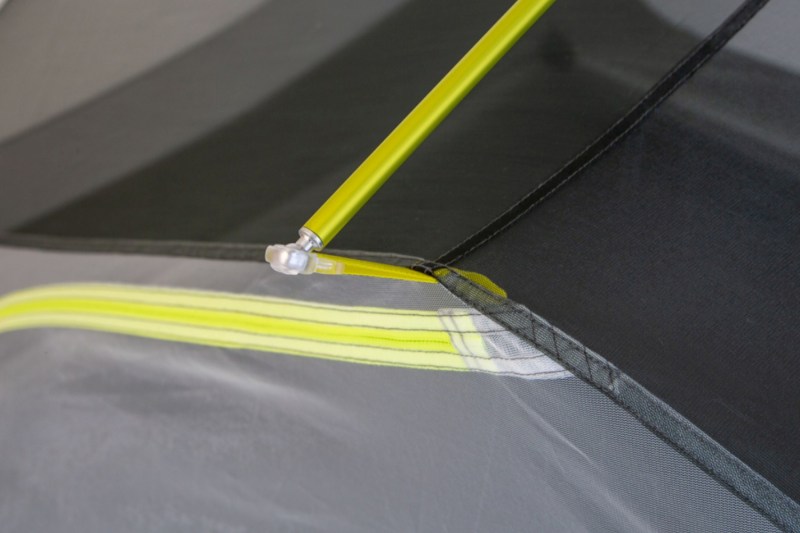I got a chance to spend the last month or so with the latest iteration of the Nemo Dagger 2P backpacking tent. The Dagger has been a beloved tent in the Nemo lineup for years, most notably because it pulls double duty as a solid camping tent for two that also happens to be fast and light enough for proper backpacking duty. The “new for 2022” model, the Nemo Dagger OSMO 2P, packs all the same features of the old Dagger, but brings a new standard to the table: It’s made from Nemo’s new 100% recycled OSMO fabric.
Light and compact, impressively weatherproof, and made from premium materials throughout, the Nemo Dagger OSMO 2P is arguably the best Dagger yet, and if you’re looking for that “one tent to rule them all” the new Dagger should be on your shortlist. Here’s my take on the Dagger OSMO 2P after a few nights in the woods.

What’s so Special About the Nemo Dagger OSMO?
There’s a lot to love about this do-it-all tent, but the big news for 2022 is Nemo’s new proprietary OSMO fabric. OSMO is a big deal. Nemo spent years developing, testing, and refining this material and the result is impressive.
Where most tents use either polyester or ripstop nylon in their construction (which is then coated in polyurethane for added water protection), OSMO fabric is made from a blend of polyester and nylon (both of which are made from 100% recycled yarns), to give it the best of both worlds. The result is an incredibly tough fabric that’s impressively waterproof, highly resistant to stretching and sagging, and faster drying than anything else Nemo has ever used in a tent.

In addition to that, OSMO’s water resistance is achieved without any added PFC chemicals, and it meets its flammability resistance requirements without using any harmful chemical additives. OSMO is a big leap for both tech and environmental sustainability, and it’s nice to know you can have your cake and eat it too without making compromises in performance.
Standout Features of the Nemo Dagger OSMO 2P
The Dagger has always been a feature-packed tent, and the latest Nemo Dagger OSMO 2P follows suit in that regard. Here are a few of the standout features that really caught my eye.
- The OSMO fabric is truly impressive in the wet. There’s a lot of marketing hoopla surrounding any new outdoors product, but I was genuinely impressed watching this tent shed water all afternoon and then on through a full night of rain. Even in heavy rain and wind, the tent stayed dry, stayed put, and I had zero issues with a sagging rainfly.
- Interior space is top-notch. The Dagger has always been known for its roomy interior, and the latest version is as good as ever. There’s plenty of width for two campers to sleep side by side without rubbing the walls of the tent, and length-wise, the Dagger OSMO’s whopping 90 inches of floor space in length means there’s tons of room left over for gear at the head and foot of the tent.
- Vestibule Storage is some of the best in the business. Both vestibules on the Dagger OSMO 2p pack a full 11.4 square feet of storage space. That’s impressive enough for a camping tent, but it’s outstanding for a backpacking model.
- Set-up and takedown are super fast and easy. The combination of a hubbed poleset and color-coding throughout the tent make assembly intuitive, and the use of multi-function “jake’s feet” to secure the tent and rainfly is carried over from the outgoing model as well.

What I Love About This Tent
The hallmark of a great “all-rounder” like the Nemo Dagger is doing pretty much everything well outdoors. The latest Dagger OSMO 2P absolutely delivers in that regard and then some. Here are some of my favorite perks of the new Dagger OSMO.
- It works as a proper backpacking tent: One of the big challenges with “plus-sized” backpacking tents like these is staying light enough and compact enough to claim backcountry compatibility without raising any eyebrows. With a packaged weight of four pounds and two ounces and a packed size of 19.5 x 6.5 x 3.5 inches (the stuff sack is rectangular), the Dagger OSMO is a reasonable carry for one and a breeze when split between two hikers.
- It’s impressively livable: When we talk backpacking tents, the single most important feature for me is livability. Size and weight are important, but I’m always willing to carry an extra ounce or two if it means having a shelter I don’t mind spending time in. The Dagger OSMO packs above average floor space and peak height for a backpacking tent, but also includes extra features that really add to its overall livability in the backcountry. Its massive twin storage vestibules keep the interior from getting cluttered, but if you do choose to store outdoor gear or equipment inside the tent, there’s plenty of extra room in there as well.
- A great tent that’s great for the planet: I’ve got to applaud Nemo on their investment in sustainability here. First and foremost is their new OSMO fabric, which is made from 100% recycled materials, yet still offers impressive waterproofing and 3x less stretch/sag when wet than other comparable ripstop fabrics. The second big sustainability push is Nemo’s ongoing polybag elimination project, which replaced the use of disposable polybags with woven bags made exclusively from recycled plastic water bottles. This simple switch keeps literal tons of plastic out of landfills and oceans every year, and for that, Nemo, I salute you.

What I Don’t Love About the Dagger OSMO 2P
The Nemo Dagger 2P has been considered one of the best “one tent solutions” out there for years. This latest Dagger OSMO 2P version is by far Nemo’s best yet, but there are a few things I’d like to see them do differently next time around.
- The footprint isn’t included: Nemo’s gear is some of the best and most advanced in the business, and as such, we expect it to command a premium price. With that being said, I don’t think it’s too much to ask for Nemo to throw in a footprint with the Dagger OSMO for the current asking price. This is a tent that’s built for split duty as a camper and a lightweight backpacker: Give us the option to have it when we want it, or leave it at home when weight and space are a priority.
- The rainfly doesn’t cover the far ends of the tent: I sat through a proper rainstorm inside the Dagger OSMO 2P, and it didn’t let a drop in, yet I couldn’t help feeling paranoid about the exposed sections of the canopy at the head and foot of the tent. Nemo uses an extra-high bathtub-style floor to protect the interior of the Dagger from runoff and splashes, but I would prefer two layers of fabric for peace of mind. Again, the system works, but in an “all-around” tent like this, I’m always willing to carry a little extra weight for added protection and longevity.
- It ain’t cheap: Good outdoor gear always costs a pretty penny, and if you want the best in materials, fabrics, and design, you invest accordingly. The Dagger OSMO 2P delivers in that regard, with top-of-the-line performance fabrics, a top-notch DAC Featherlite NSL poleset, and an impressively livable design. With that being said, it’s up against steep competition at this price from heavy hitters like the Big Agnes Copper Spur UL2 and MSR Hubba Hubba 2. Ultimately it’s up to the buyer to decide whether the Dagger’s tough fabric and impressive vestibule space give it the advantage here, but if it were about $50 cheaper, I think that decision would be much easier.

FAQs About The Nemo Dagger OSMO 2P
Considering the Nemo Dagger OSMO 2P as your next do-it-all outdoors shelter? Here are some of the internet’s most popular questions answered.
What other sizes are available for the new Nemo Dagger OSMO?
Nemo currently sells the updated Dagger OSMO in both two and three-person sizes. If you’re looking for a one-person tent with the new OSMO fabric, the Nemo Hornet has also been given the OSMO treatment for 2022.
Is the new recycled OSMO fabric as tough as the original Dagger?
Nemo doesn’t list their fabric specs in denier ratings anymore, but after spending a month with the new OSMO fabric, I can safely say it’s properly tough and weatherproof. I have yet to use the Dagger with a footprint, and even after pitching it on some questionable surfaces in a hurry, I’ve had zero tears, scrapes, or visible wear to speak of. The fact that this design works so well in the rain also speaks to the quality waterproofing of OSMO. I had overnight rains without a single drop making its way through the fly or the walls of the tent.
Is the new Nemo Dagger OSMO worth the money?
This is a fair question, and one you’ll have to decide for yourself. If you’re already considering a tent at this price point, the short answer is yes, I believe the Dagger OSMO is on par with the competition. As I see it, the main reasons to pick the Nemo over something like an MSR or Big Agnes alternative are (a) the excellent vestibule storage, (b) the added interior space that makes this a true two-person tent, and (c) knowing that your money is going toward a brand that’s making a serious effort in the environmental space.
Should You Buy the Nemo Dagger OSMO 2P?
If you’re looking for a single tent to pull double duty as a comfortable camper and a solid backpacker, the Nemo Dagger OSMO 2P is a great buy. Granted, there are certainly less expensive options out there in the genre like the , but they tend to weigh a bit more, pack down a bit less, and skimp on a few of the premium features.
If you’re already shopping in this price range, you’ll be hard-pressed to find a tent this well-made with this much vestibule storage and interior space. The fact that the new OSMO fabric is both incredibly tough, impressively waterproof, and 100% recycled is just icing on the cake.




